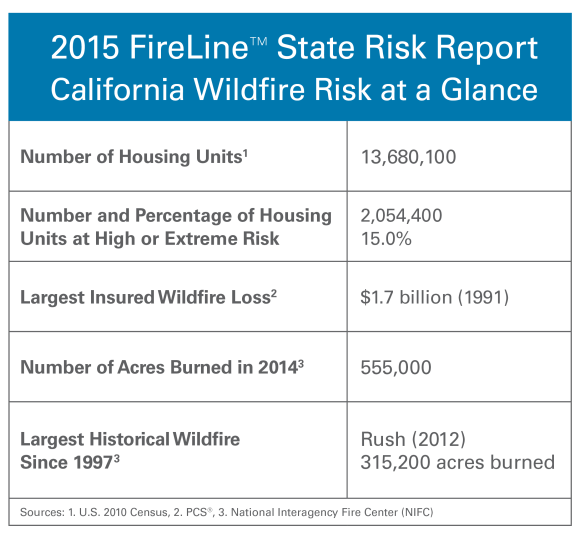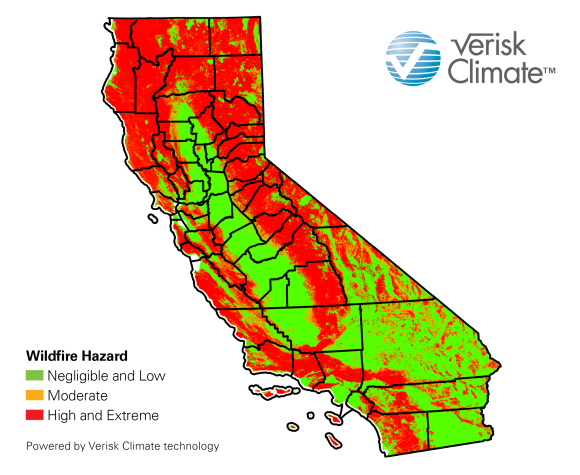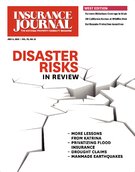A report issued in June shows California has more than 2 million homes at “high” or “extreme” wildfire risk, as the multi-year drought continues to stoke fears among some experts of a potentially devastating wildfire season.
Verisk Insurance Solutions’ 2015 FireLine State Risk report summarizes wildfire risk in 13 wildfire-prone states in the West and Southcentral U.S., and it includes three states not in past reports: Montana, Oklahoma and Wyoming.
According to the report, more than 4.5 million U.S. homes are rated at “high” or “extreme” risk of wildfire.
The report rates California as the nation’s biggest wildfire risk. Of the state’s 13.68 million homes, more than 15 percent are at “high” or “extreme” wildfire risk. More than 1.66 million homes are considered to be at “moderate” risk.
Arindam Samanta, senior manager of underwriting products and analytics at Verisk, pointed to that 15 percent figure as a particular concern, because the brunt of losses in wildfires typically occur to properties in those riskiest categories.
“Historically, what we have seen is a very high percentage of losses – close to the 90 percent range – in the ‘high’ to ‘extreme’ category,” Samanta said.
Neil Spector, Verisk’s president of underwriting, was equally concerned about the pervasive drought.
“Worsening drought conditions in the western states indicate that 2015 has the potential to be one of the most devastating wildfire seasons on record,” Spector said in a statement.
An El Niño pattern appears more than likely, but it’s debatable whether that will yield greater or fewer big wildfire outbreaks in California.
Samanta acknowledged the periodic weather pattern could bring more storms early on in the fall, California’s traditional wildfire season, and make for potentially more wildfires. However, it could just bring more rain and fewer wildfires, he said.
Heath Hockenberry, national fire weather program manager for the National Weather Service, said it’s likely El Niño will bring more rain.
“California this summer is entering into a predictive strong El Niño,” Hockenberry said.
Because of the potential El Niño, Hockenberry’s current outlook is for a normal fire season for most of California, except for areas of Northern California where vegetation (fuel) growth has been strong in the last few years, as well as some parts of Southern California. He’s also forecasting above normal fire seasons for Washington, Oregon, parts of Arizona, Idaho and Hawaii.
The latest U.S. Drought Monitor report shows most of California and some of Nevada to be under “exceptional” drought conditions, the most several rating in that report. Even the normally wetter northern portion of the state is under “extreme” or “severe” drought categories.
Rains in May and an unusually drizzily June didn’t help much, according to the drought report.
The report shows that no improvements were made to the four-year-and-counting drought picture and it called the long-term hydrologic conditions “dire.”
“In fact, the green-up of vegetation and sprouting of grasses will most-likely provide extra fuel for wildfires,” the report states.
The Verisk report shows the top five California counties with the most homes in the riskiest categories are:
- Los Angeles (444,200)
- San Diego (251,100)
- San Bernardino (112,200)
- Ventura (81,600)
- Alameda (76,800)
After California, Texas has the next highest number of homes (706,200) considered high to extremely high wildfire risk, followed by Colorado (363,900), Arizona (227,100), Idaho (163,500), Washington (157,900), Oregon (153,400), Oklahoma (148,800), Montana (130,200) and Utah (128,800).
The report shows states with the highest percentage of households at high or extreme risk of wildfire are Montana (27 percent), Idaho (25 percent), Colorado (16.4 percent), California (15.0 percent) and New Mexico (13.9 percent).


Topics California Catastrophe Natural Disasters Wildfire Homeowners
Was this article valuable?
Here are more articles you may enjoy.


 Hurricane Beryl: Insurers See Minimal Impact, Brace for Active Season
Hurricane Beryl: Insurers See Minimal Impact, Brace for Active Season  Progressive Q2 Net Income Skyrockets Over 320%
Progressive Q2 Net Income Skyrockets Over 320%  Deere Retreats From Diversity Measures After Online Attacks
Deere Retreats From Diversity Measures After Online Attacks  Hacker Says AT&T Paid About $400,000 to Erase Sensitive Data
Hacker Says AT&T Paid About $400,000 to Erase Sensitive Data 


